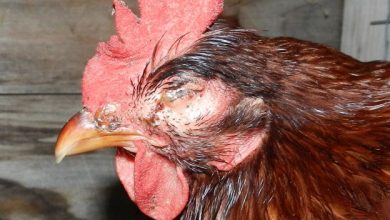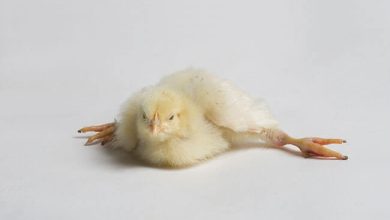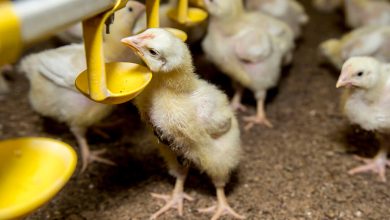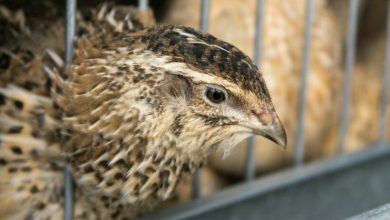Concept of Biosecurity in Poultry Farms

Concept of Biosecurity in Poultry Farms: Indian Perspective
P.K. Shukla, Amitav Bhattachayya and Ambika Sharma*
Department of Poultry Science,
College of Veterinary Science and Animal Husbandry, Mathura- 281001 (U.P.)
- Department of Veterinary Biochemistry.
Biosecurity in poultry farms refers to a set of practices and measures implemented to prevent the introduction and spread of diseases or pathogens within the poultry population. It aims to protect the health and welfare of the birds, minimize economic losses, and maintain the overall sustainability of the poultry industry. Here are some key aspects of biosecurity in poultry farms:
Restricted Access: Controlling access to the poultry farm is crucial to prevent the entry of unauthorized personnel, vehicles, or animals that could introduce diseases. Establishing designated entry points and implementing strict visitor protocols, including disinfection procedures, can help minimize the risk of disease transmission.
Isolation and Quarantine: Newly acquired birds should be quarantined for a specific period before introducing them to the existing flock. This allows for observation and testing to identify any potential disease issues. Isolation of sick birds or those showing signs of illness is essential to prevent the spread of infectious diseases.
Cleanliness and Disinfection: Regular cleaning and disinfection of poultry houses, equipment, and vehicles are vital to eliminate pathogens. Proper disposal of carcasses, waste, and litter is necessary to minimize disease transmission. Effective disinfectants and proper disinfection protocols should be followed.
Pest and Vector Control: Implementing measures to control pests, such as rodents, insects, and wild birds, is important as they can act as disease carriers. This includes proper waste management, securing feed storage areas, and maintaining a clean and well-maintained farm environment.
Biosecurity Zones: Establishing biosecurity zones within the farm can help prevent the spread of diseases. These zones can include areas for clean and dirty activities, such as changing clothes and boots, as well as separate zones for different age groups of birds.
Worker Hygiene: Proper personal hygiene practices for farm workers, including handwashing, use of protective clothing, and disinfection protocols, are essential to prevent the introduction and spread of diseases. Training workers on biosecurity practices and enforcing their adherence is crucial.
Disease Surveillance and Monitoring: Regular monitoring and surveillance for diseases, including routine health checks, testing, and reporting of any abnormal signs or mortality, can help detect diseases early and initiate appropriate control measures.
Vaccination Programs: Implementing a robust vaccination program based on the advice of veterinarians and in accordance with regional disease risks is crucial to protect birds from specific diseases.
Farm Management and Records: Maintaining accurate records of bird movements, health status, treatments, and vaccinations can aid in traceability and disease management. Proper farm management practices, such as maintaining optimal flock density and avoiding overcrowding, also contribute to disease prevention.
Education and Training: Providing education and training to farm workers, veterinarians, and other stakeholders about biosecurity measures and their importance is key to ensuring compliance and understanding the significance of disease prevention.
Biosecurity is a critical aspect of poultry farming and plays a significant role in preventing the introduction and spread of diseases. By implementing comprehensive biosecurity practices, poultry farms can reduce the risk of disease outbreaks, protect bird health, and maintain the overall productivity and sustainability of the industry.
Types of biosecurity in poultry farms
External Biosecurity:
These measures are aimed at preventing the entry of diseases from outside sources into the poultry farm. They include:
- Perimeter Security: Installing secure fencing, gates, and signage to control access to the farm premises and prevent unauthorized entry.
- Traffic Control: Implementing protocols for vehicles, equipment, and personnel entering the farm to minimize the risk of disease transmission. This may involve designated entry points, biosecurity checks, and visitor logbooks.
- Wild Bird Management: Implementing measures to deter or prevent wild birds from entering poultry areas, such as netting, scare devices, or habitat management.
- Pest Control: Implementing pest control measures to prevent the entry and transmission of pests that may carry diseases, such as rodents and insects.
Internal Biosecurity:
These measures are focused on preventing the spread of diseases within the poultry farm. They include:
- Segregation and Separation: Implementing physical barriers or separate production areas for different age groups, species, or production types to prevent disease transmission.
- Traffic Flow: Establishing designated routes for personnel, equipment, and materials within the farm to minimize cross-contamination between different areas or groups of birds.
- Cleanliness and Sanitation: Maintaining high standards of cleanliness and hygiene, including regular cleaning and disinfection of poultry houses, equipment, and tools.
- Waste Management: Proper disposal of litter, manure, carcasses, and other waste materials to minimize disease risks and prevent the attraction of pests.
- Water and Feed Management: Ensuring a clean and safe water supply, as well as proper storage, handling, and quality control of feed to minimize disease transmission.
Structural Biosecurity in Poultry Farms:
Structural biosecurity in poultry farms refers to the physical infrastructure and design elements implemented to minimize the entry and spread of diseases within the poultry production facility. It involves constructing and maintaining the farm layout, buildings, and equipment in a way that reduces the risk of disease transmission. Here are some key considerations for structural biosecurity in poultry farms:
- Site Selection: Choosing an appropriate site for the poultry farm is essential. It should be located away from other poultry farms, wildlife habitats, and areas prone to flooding or contamination. Proper drainage and soil management should be ensured to prevent waterlogging and disease risks.
- Perimeter Fencing: Installing secure perimeter fencing around the poultry farm helps control unauthorized entry and reduces the risk of contact between poultry and outside animals or humans. The fencing should be constructed with materials that discourage burrowing or climbing by pests or predators.
- Controlled Access Points: Designating specific entry and exit points with controlled access is crucial for maintaining biosecurity. These access points should have proper biosecurity measures, including footbaths, handwashing stations, and disinfection protocols to prevent the introduction and spread of pathogens.
- Separate Production Areas: Separating different production areas within the farm, such as broiler houses, layer houses, and hatcheries, helps prevent cross-contamination and disease spread. Each production area should have its own dedicated equipment, supplies, and personnel to minimize the risk of disease transmission between different flocks.
- Adequate Space and Ventilation: Providing sufficient space and proper ventilation in poultry houses is important for maintaining optimal air quality, reducing moisture levels, and preventing the buildup of harmful gases. Good ventilation helps control the spread of airborne pathogens and promotes the overall health of the birds.
- Surface Materials and Cleaning: Choosing appropriate surface materials for the poultry house floors, walls, and equipment that are easy to clean, disinfect, and maintain is essential. Smooth, non-porous materials are preferred as they are less likely to harbor pathogens and are easier to sanitize.
- Waste Management: Implementing effective waste management practices, including proper disposal of litter, manure, and carcasses, is crucial to minimize disease risks. Adequate storage facilities and regular removal of waste from the farm help prevent the buildup of pathogens.
- Pest Control Measures: Implementing measures to control pests and vectors, such as rodents, insects, and wild birds, is important. This includes using pest-proof construction materials, sealing openings, and employing pest control methods to prevent disease transmission.
- Water Management: Ensuring a clean and safe water supply is essential for maintaining bird health and preventing the transmission of waterborne diseases. Proper water source management, water quality testing, and regular cleaning of water lines and equipment are necessary.
- Emergency Preparedness: Incorporating emergency response plans, including isolation areas and quarantine facilities, in the farm’s structural design is important for managing disease outbreaks effectively. This allows for the rapid response, containment, and control of diseases.
By incorporating these structural biosecurity measures, poultry farms can minimize the risk of disease introduction and spread, maintain a healthy flock, and safeguard the overall biosecurity of the facility. It is important to regularly assess and update the farm’s infrastructure and practices to ensure ongoing biosecurity effectiveness.
Operational Biosecurity in poultry farms:
Operational biosecurity in poultry farms refers to the day-to-day management practices and protocols that are implemented to minimize the risk of disease introduction and spread within the facility. It involves the actions taken by farm personnel and stakeholders to maintain strict hygiene standards, prevent disease transmission, and promote overall biosecurity. Here are some key aspects of operational biosecurity in poultry farms-
- Personnel Hygiene: Farm workers and visitors should adhere to strict hygiene practices. This includes washing hands thoroughly with soap and water before entering and leaving the poultry area, using designated footbaths or footwear disinfection stations, and wearing appropriate protective clothing, such as boots, coveralls, and gloves.
- Clothing and Equipment Management: Dedicated clothing and equipment, including boots, coveralls, and tools, should be provided and used exclusively within specific poultry areas. These items should be regularly cleaned and disinfected to prevent the introduction and spread of pathogens.
- Traffic Control: Implementing a clear traffic control system within the farm helps prevent cross-contamination between different production areas or groups of birds. This can include designated routes, signage, and barriers to ensure separation and minimize contact between different flocks.
- Sanitation and Cleaning: Regular and thorough cleaning and disinfection of poultry houses, equipment, and vehicles are critical to eliminate pathogens. Cleaning protocols should be in place, specifying the appropriate cleaning agents, disinfectants, and procedures. Paying special attention to high-risk areas, such as feeders, waterers, and egg collection areas, is important.
- Feed and Water Management: Ensuring a clean and safe supply of feed and water is vital for maintaining bird health and preventing disease transmission. Implementing good storage practices, monitoring feed quality, and regularly cleaning and disinfecting water lines and drinkers are essential.
- Pest and Rodent Control: Implementing effective pest and rodent control measures helps prevent disease transmission. Regular inspections, use of traps and baits, and proper waste management are crucial to minimize the risk of pest infestations.
- Biosecurity Training and Education: Providing regular training and education to farm personnel and stakeholders about biosecurity practices and their importance is essential. This ensures that everyone understands and follows proper protocols to prevent disease transmission.
- Record Keeping and Documentation: Maintaining accurate and up-to-date records of flock health, vaccination history, treatments, mortality rates, and other relevant information is important. These records aid in disease management, traceability, and identifying potential areas for improvement.
- Monitoring and Surveillance: Regular monitoring of bird health, behavior, and production performance is necessary to detect any signs of disease or abnormalities. Prompt reporting and appropriate actions should be taken in case of suspected disease outbreaks.
- Emergency Preparedness: Developing and implementing emergency response plans that outline the steps to be taken in the event of a disease outbreak is crucial. This includes having isolation and quarantine facilities, contact information for veterinary support, and protocols for disease containment and control.
By implementing robust operational biosecurity measures, poultry farms can minimize the risk of disease introduction and spread, protect the health and welfare of the birds, and maintain the overall biosecurity of the facility. It is important to regularly review and update operational biosecurity protocols to adapt to changing disease risks and best practices.




